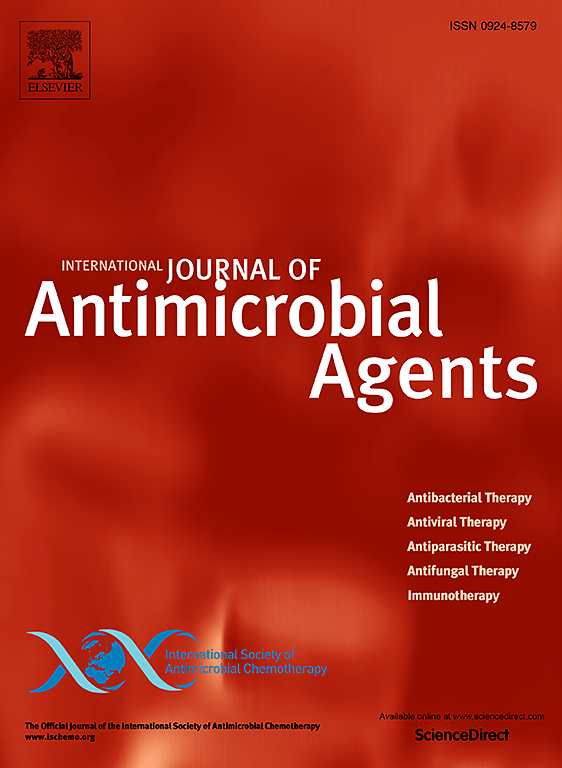Diagnostic and epidemiological landscape of anaerobic bacteria in Europe, 2020–2023 (ANAEuROBE)
IF 4.9
2区 医学
Q1 INFECTIOUS DISEASES
International Journal of Antimicrobial Agents
Pub Date : 2025-02-28
DOI:10.1016/j.ijantimicag.2025.107478
引用次数: 0
Abstract
Introduction
Despite being implicated in a wide spectrum of community- and healthcare-acquired infections, anaerobes have not yet been incorporated into systematic surveillance programs in Europe.
Methods
We conducted a multicentre retrospective observational study analysing all anaerobic strains isolated from blood cultures in 44 European Hospital Centres over a 4-y period (2020–2023). Diagnostic approach, epidemiology, and antimicrobial susceptibility according to EUCAST v. 15.0 were investigated.
Results
Our study included 14,527 anaerobes, most of which were Gram-positive (45%) or Gram-negative (40%) bacilli. MALDI-TOF coupled to mass spectrometry was the most widely used tool for species identification (98%). Antimicrobial susceptibility testing was performed in the vast majority of centres, using mostly gradient diffusion strip (77%) and disk diffusion (45%) methods according to EUCAST guidelines. The most prevalent species were Cutibacterium acnes (18.7%), Bacteroides fragilis (16.3%), Clostridium perfringens (5.3%), Bacteroides thetaiotaomicron (4.2%), Fusobacterium nucleatum (3.5%), and Parvimonas micra (3.4%). C. acnes showed high resistance to benzylpenicillin (18%), clindamycin (39%), and imipenem (19% and 13% by MIC methods and disk diffusion, respectively). B. fragilis showed high resistance to amoxicillin/clavulanate (24%), piperacillin/tazobactam (22% and 14% by MIC methods and disk diffusion, respectively), clindamycin (22% by both MIC methods and disk diffusion), meropenem (13%), and metronidazole (10%, only by disk diffusion). A similar resistance pattern was observed in B. thetaiotaomicron, Bacteroides ovatus, and Parabacteroides distasonis. C. perfringens showed high resistance to clindamycin (69% and 45% by MIC methods and disk diffusion, respectively), while benzylpenicillin and metronidazole maintained over 90% activity. F. nucleatum showed high resistance to benzylpenicillin (11%), while Fusobacterium necrophorum showed alarming rates of resistance to clindamycin (12%), meropenem (16%) and metronidazole (11%).
Conclusions
This study presented an up-to-date analysis of the diagnostics and epidemiology of anaerobic bacteria in Europe, providing insights for future comparative analyses and the development of antimicrobial diagnostic and management strategies, as well as the optimization of current antibiotic treatments.
欧洲厌氧菌诊断和流行病学景观,2020-2023年(ananeurobe)。
导言:尽管厌氧菌与广泛的社区和医疗保健获得性感染有关,但在欧洲,厌氧菌尚未纳入系统的监测计划。方法:我们进行了一项多中心回顾性观察性研究,分析了44家欧洲医院中心在4年期间(2020-2023年)从血液培养中分离出的所有厌氧菌株。根据EUCAST v. 15.0对诊断方法、流行病学和抗菌药物敏感性进行了调查。结果:共纳入厌氧菌14527株,以革兰氏阳性(45%)或革兰氏阴性(40%)杆菌为主。MALDI-TOF耦合质谱是最广泛使用的物种鉴定工具(98%)。在绝大多数中心进行了抗菌药敏试验,根据EUCAST指南(v. 15.0),主要采用梯度扩散条(77%)和纸片扩散法(45%)。最常见的菌种为痤疮表皮杆菌(18.7%)、脆弱拟杆菌(16.3%)、产气荚膜梭菌(5.3%)、太古微拟杆菌(4.2%)、核梭杆菌(3.5%)和微细小单胞菌(3.4%)。痤疮C.对青霉素(18%)、克林霉素(39%)、亚胺培南(19%)和盘片扩散法(13%)耐药。脆弱芽孢杆菌对阿莫西林/克拉维酸酯(24%)、哌拉西林/他唑巴坦(22%)、克林霉素(22%)、美罗培南(13%)、甲硝唑(10%)均表现出较高的耐药水平。同样的耐药模式也出现在白僵杆菌、卵形拟杆菌和异裂副杆菌中。产气荚膜荚膜荚膜菌对克林霉素的抗性较高(MIC法和纸片扩散法分别为69%和45%),青霉素和甲硝唑的抗性维持在90%以上。具核梭菌对青霉素的耐药率较高(11%),而对克林霉素(12%)、美罗培南(16%)和甲硝唑(11%)的耐药率惊人。结论:本研究对欧洲厌氧菌的诊断和流行病学进行了最新的分析,为未来的比较分析、抗菌诊断和管理策略的发展以及当前抗生素治疗的优化提供了见解。
本文章由计算机程序翻译,如有差异,请以英文原文为准。
求助全文
约1分钟内获得全文
求助全文
来源期刊
CiteScore
21.60
自引率
0.90%
发文量
176
审稿时长
36 days
期刊介绍:
The International Journal of Antimicrobial Agents is a peer-reviewed publication offering comprehensive and current reference information on the physical, pharmacological, in vitro, and clinical properties of individual antimicrobial agents, covering antiviral, antiparasitic, antibacterial, and antifungal agents. The journal not only communicates new trends and developments through authoritative review articles but also addresses the critical issue of antimicrobial resistance, both in hospital and community settings. Published content includes solicited reviews by leading experts and high-quality original research papers in the specified fields.

 求助内容:
求助内容: 应助结果提醒方式:
应助结果提醒方式:


